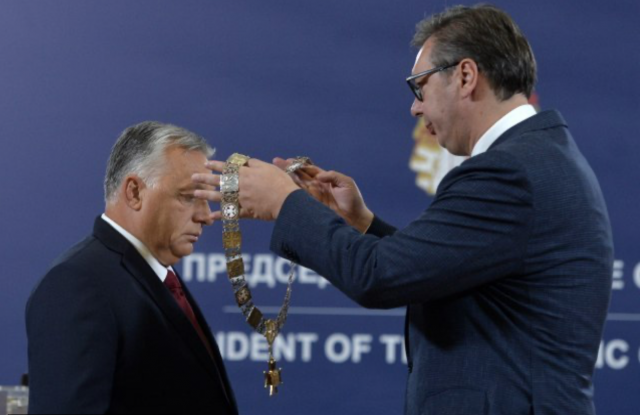A Danubian Axis has formed in the middle of Europe that challenges democratic development in each member state and undermines the security of the continent. The governments in Hungary, Serbia, Slovakia, and the Republika Srpska in Bosnia-Herzegovina are constructing an alliance intended to upend the principles of European unity and NATO’s trans-Atlanticism. And their chief patron is Vladimir Putin’s Russia.
Danubian Axis governments operate on several key principles. They are EU-skeptic but seek to profit from the common EU budget, whether as members such as Hungary or as applicants, in the case of Serbia. They seek to limit democratic choice and political pluralism and to ensure future election victories through control over the mass media and state institutions. They are more corrupt than other governments as accountability is limited, investigations are stifled, and the ruling parties control all major financial flows. And they are invariably pro-Russian and anti-American, as Washington pushes for democracy while Moscow welcomes predictable autocrats who can be used for its expansionist designs.
Hungary has been the leader of the Danubian Axis for several years since Victor Orbán first became Prime Minister in 2010. Orbán’s Fidesz party has deeply rooted itself in all state institutions, media, and government agencies, sidelined rival political contenders, and depicted itself to the electorate as the defenders of Hungarian independence against European and American interference. It is not their social conservative or “illiberal” values that are the most problematic for Hungary’s place in Europe, but state capture by the ruling party and the weakening of democratic principles in a strategy to perpetuate Fidesz rule.
Under the Aleksandar Vućić regime, Serbia joined the Danubian Axis and maintains a particularly close relationship with Orbán’s Hungary. Vućić admires Orbán’s disruption of EU decision-making and Hungary’s minimalist contributions to NATO security. In return, Orbán has tacitly supported Serbia’s claims to be the Western Balkan hegemon, employed anti-Bosnian and anti-Albanian rhetoric under the guise of defending “Christian culture” and “European values,” and openly bolstered the position of Milorad Dodik in Bosnia’s Republika Srpska.
Slovakia entered the Danubian Axis following the September 2023 parliamentary elections and the return to power of Prime Minister Robert Fico. Fico has maintained close personal and economic relations with Moscow but his popularity stems mostly from widespread dissatisfaction with the previous government during a period of high inflation. Nonetheless, unlike in Hungary, Fico’s Smer party only holds a slender parliamentary majority in a three-party coalition and cannot engage in overtly controversial policies that would alienate his partners and precipitate a new election. Slovakia’s membership of the Danubian Axis is therefore less certain and durable than that of Hungary or Serbia. In addition, Fico is more of an opportunist than an ideologue. For instance, during his recent visit to Ukraine he affirmed his support for Ukraine’s territorial integrity and pledged to continue weapons sales to Kyiv.
The Czech Republic, Croatia, Slovenia, and Austria could also join the Danubian Axis for variable spells, as nationalist, populist, or opportunist politicians exploit public anger with economic conditions and the influx of non-European migrants. Social discontent is particularly evident in the Czech Republic amidst rising public support for the ANO opposition party led by former Prime Minister and billionaire with Russian connections, Andrej Babiš. Parliamentary elections are scheduled for 2025 and the current premier, Petr Fiala, confronts growing public distrust following a series of crises over an influx of refugees, rising energy costs, and soaring inflation.
Croatia faces parliamentary elections in the spring and a presidential election by the end of the year. The ruling Croatian Democratic Union (CDU) has tried to emulate Orbán and Vućić in making its rule more permanent but faces resistance from the Social Democrats and President Zoran Milanović. Outside Croatia’s borders, the CDU’s main focus has been on assisting their nationalist compatriots in Bosnia-Herzegovina to divide the country into three autonomous entities. All actions to remove the democratically elected Croatian leader Željko Komšić, who is committed to a civic state, from the Bosnian presidency are aimed at Bosnia’s division and potential partition. Hence, Zagreb’s interests in Bosnia coincide with those of Belgrade even though the two governments cannot create a more cohesive or durable alliance because of persistent historical conflicts and hostile Serbian and Croatian nationalisms.
Austria and Slovenia are also candidates for the Danubian Axis. Austria’s military neutrality and stubborn insistence to stay out of NATO has always benefited Russia. Successive governments in Vienna have traditionally maintained cordial relations, business ties, and energy connections with Moscow. In particular, the third largest political group, the far-rightist and openly pro-Putin Freedom Party, has either been part of a coalition government or pushed Austria’s agenda toward supporting Moscow. Some Slovenian politicians have also toyed with Russia’s version of “pan-Slavism,” as well as national populism and ultra-conservatism, while developing closer links with Orbán’s Hungary.
There is no simple cure to neutralize an axis that thrives on political polarization and the weakening of continental security against the threat from Moscow. Nonetheless, as European leaders increasingly focus on building up credible defenses against Russia and not simply relying on American leadership, they must be clear in dealing with the Danubian laggards. NATO members Hungary and Slovakia must meet their defense spending obligations, while NATO opponents such as Serbia and even Austria will need to curtail their economic and political links with Moscow if they are to benefit from EU funding. The Danubian axis is not trusted by the front line states facing imperial Russia. If a war between Europe and Russia were to explode in the next few years, as defense ministers in Germany, Sweden, Norway, Finland, Poland, and other countries have recently warned, one wonders which side Budapest and Belgrade will be supporting?
Janusz Bugajski is a Senior Fellow at the Jamestown Foundation in Washington DC. His recent book is Failed State: A Guide to Russia’s Rupture. His forthcoming book is titled Pivotal Poland: Europe’s Rising Strategic Player.































